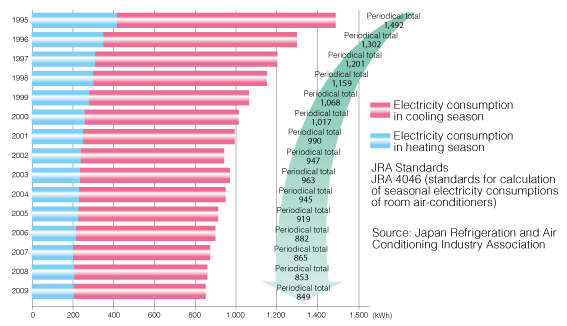With the advent of inverter air-conditioners, the full-scale age of air-conditioners came in the 1980s. An inverter is a mechanism that freely changes the RPM of compressor that compresses the refrigerant that conveys heat. With alternative current, the RPM of a motor is constant in proportion of the frequencies of electricity. For this reason, air-conditioners in olden days had poor efficiency as they could not cope with temperature changes because of “operation at constant RPM speed”. With the advent of inverter air-conditioners, their performance significantly improved.

Inverters made it possible to "operate air-conditioners at variable RPM in proportion to frequencies. Inverter air-conditioners operate at a high RPM speed at the start of operation and achieve the set temperature in a short time. For both cooling and heating, inverter air-conditioners shift to low-RPM operation once they achieve a desirable preset temperature, and then operate at flexible RPM to maintain the temperature. Therefore, comfortable room temperatures can be maintained by small power consumption.
Competition for efficiency under Top Runner Regulations*
As a result of development competition for improvement of efficiency due to the effect of the Top Runner Program that was introduced after the amendment of the Act on the Rational use of Energy in April 1999, the average cooling and heating efficiency of air-conditioners for household use has increased by about twice as much in the past ten years or so to COP = 6.7. Centrifugal chillers for business use have also achieved COP = 7.0 as their efficiency has increased by about 40%, though they are not covered by the Top Runner Program. Moreover, “Eco Cute” CO2-refrigerant heat pump water heater that was commercialized for the first time in Japan in 2001 also improved its “mid-term coefficient of performance (COP)” and achieved COP = 5.1. In recent years, focus has been put on the improvement of annual performance factor, and the efficiency of “Annual Performance Factor (APF) of Overall Hot Water Supply System” as a new performance assessment method that started in 2007 has improved and APF has reached 3.9. At present, it is now considered applying the Top Runner Program to Eco Cute heat pump equipment. Discussions about target standard values are now underway by the subcommittee on heat pump water heater judgment criteria under the Energy Efficiency Standards Subcommittee of the Advisory Committee for Natural Resources and Energy to work out a report in about June 2011. In recent years, heat pump hot water floor heating equipment have begun coming into wide use, and highly efficient equipment whose COP reaches 4.4 is also placed on the market.
* The top runner regulations are a regulatory program that was introduced in the latter half of the 1990s in Japan as a mechanism to foster continuous improvement of efficiency of energy-consuming equipment such as vehicles and home electric appliances. Specifically speaking, the top runner regulations have made it mandatory for those companies that produce or import the specific products designated by the Law Concerning the Rational Use of Energy to improve the energy-saving performance of their products higher than that of respective best products now made available on the market by the target fiscal year.
